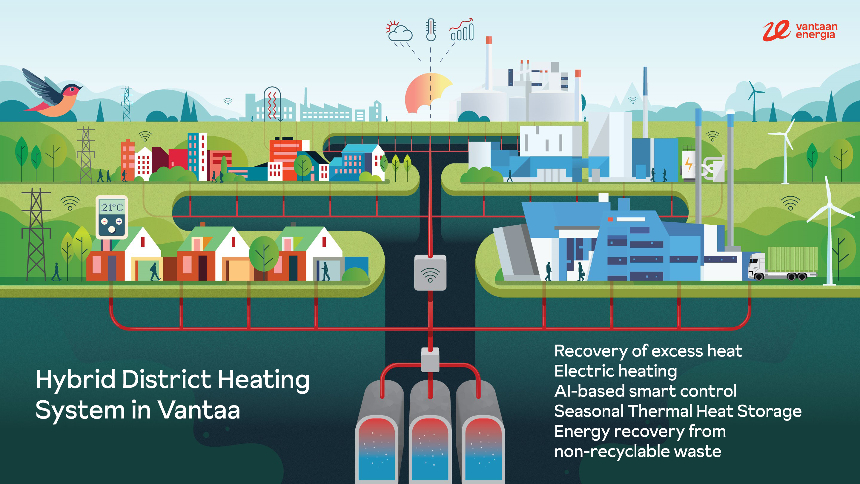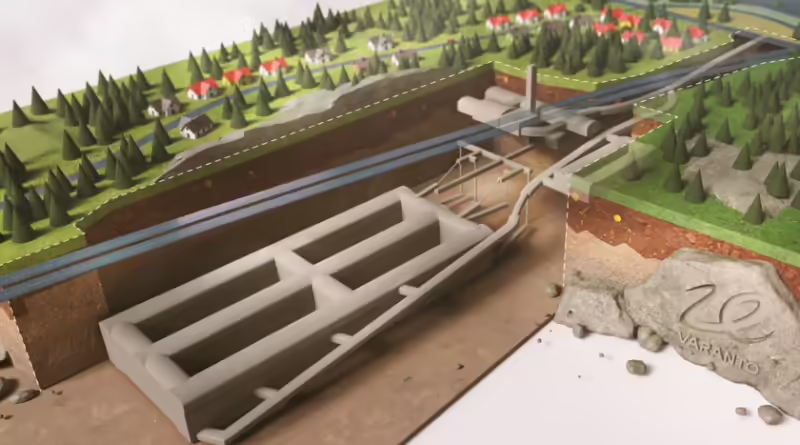Vantaa Energy To Build 90 GWh Thermal Battery For District Heating In Finland
Finland is known for several things, like producing fast racing drivers, northern lights, saunas, and district heating. Some say its citizens are the happiest people on Earth, possibly because of their fondness for watching those northern lights while sitting naked in an outdoor sauna with friends as they imbibe potent libations. It is also known for being quite chilly at times, which means it has placed a heavy emphasis on keeping its built environment warm during the winter months — which is to say between August 15 and July 9th of the following year.
Many European cities use district heating — something that is unfamiliar to most Americans. Instead of having individual furnaces in every home and building, they produce heat in bulk and distribute it to all the buildings in the community using a system of hot water pipes. Conceptually, it is like the cooling system in a conventional car. Vantaa is the fourth largest city in Finland, which means it already has a well-functioning district heating system. But the heat for that system comes from many sources, not all of which are free of carbon emissions.
Vantaa Energy has a plan to convert the city’s district heating system to one that takes advantage of renewable energy instead. The project, known as Veranto, is set to begin construction later this year and will use two 60 MW electric boilers to heat the water for the system. Waste heat from local industries will also be captured to help heat the water. The hot water will be stored in three massive underground chambers buried deep underground. Just like the cooling system in a conventional car, the system will be pressurized to allow the temperature of the water to reach 140º C (284º F). Vantaa Energy says the completed system will store up to 90 GWh of energy — enough to heat a medium-sized city like Vantaa for a year and making it the largest thermal energy storage system in the world.
Constructing A Thermal Battery
The scale of the project is enormous. There will be three chambers buried 100 meters (330 feet) underground. Each chamber will measure 300 meters (984 feet) in length, 40 meters (131 feet) high, and 20 meters (66 feet) wide. The combined volume of all three chambers, including processing facilities, will be 1.1 million cubic meters (39 million cubic feet). When completed, Veranto will be the largest thermal energy storage system in the world.
“The world is undergoing a huge energy transition,” says Jukka Toivonen, CEO of Vantaa Energy. “Wind and solar power have become vital technologies in the transition from fossil fuels to clean energy. The biggest challenge of the energy transition so far has been the inability to store these intermittent forms of energy for later use. Unfortunately, small scale storage solutions such as batteries or accumulators are not sufficient. Large industrial scale storage solutions are needed.”
Varanto will help Vantaa Energy to do more from less, as it will be able to store heat that was previously wasted for use at a later time. The Varanto sytem is a giant step towards a hybrid district heating system. The smartest possible generation method can be chosen for each moment and different energy sources can be taken full advantage of. At its best, the heat-producing system will work like a hybrid car — sometimes running on electricity, sometimes on other sources. The city’s district heating network will distribute that heat in accordance with a sophisticated control system. In this way, the utility company can secure an affordable and stable price for its customers while eliminating emissions.
The project, valued at around €200 million, is financed by Vantaa Energy, but has already been awarded a €19 million investment grant from Finland’s Ministry of Economic Affairs and Employment. Construction of the storage facility’s entrance is expected to start in summer 2024, and the seasonal thermal energy storage facility could be operational as early as 2028.
A Deep Dive Into District Heating

District heating is the most popular form of heating for properties and homes in large cities in Finland. It is made possible by an underground network that most of the buildings are connected to. Finland is the largest producer of district heat in the Nordic countries. The district heating network links energy production and users. The energy that flows through the network is as environmentally friendly as the generation forms connected to it. New technologies can be integrated into the district heating network as production methods evolve, which makes the system highly adaptable.
 Chip in a few dollars a month to help support independent cleantech coverage that helps to accelerate the cleantech revolution!
Chip in a few dollars a month to help support independent cleantech coverage that helps to accelerate the cleantech revolution!
District heating is efficient because heat is produced close to where it is needed. For the people of Vantaa, it is produced at the waste-to-energy plant which uses mixed household waste together with commercial and industrial waste that cannot be recycled. Heat is also produced at Martinlaakso power plant, which burns domestically sourced wood for fuel. District heating is an important choice for many companies and cities seeking ways to achieve their climate targets. The district heating network enables entire cities to become carbon neutral, as the network makes it easy to deliver climate-friendly heat to residents and businesses.
A district heating network is a closed, two-pipe underground network in which the thermal energy produced flows to users as hot water. One pipe carries the hot water to the buildings, while the other pipe returns the water that has released its thermal energy so that it can be reheated. The heat is transferred to the various buildings via heat exchangers so that the actual district heating water does not circulate in the heating network of the buildings.
The temperature of the water going to buildings is between 80 and 115° C (175 to 240º F), depending on the weather. In the return pipe, the water that has released its thermal energy is typically around 35 to 50° C (95 to 112º F). Modern district heating pipes are extremely low maintenance and have a long service life — up to 100 years. The Vantaa region has a total of 600 kilometers of district heating network.
Vantaa Energy has reduced carbon emissions from its energy production by more than 70% compared to 2014 levels. Work towards increasingly climate friendly energy continues and Vantaa Energy aims to be a carbon negative circular economy energy company by 2030. Its carbon negative plans are based on circular economy solutions to ensure that energy and limited resources are circulated as smartly as possible. District heating that used renewables is a big step forward in keeping the built environment comfortable without loading the atmosphere with pollutants.
Have a tip for CleanTechnica? Want to advertise? Want to suggest a guest for our CleanTech Talk podcast? Contact us here.
Latest CleanTechnica.TV Videos

CleanTechnica uses affiliate links. See our policy here.

